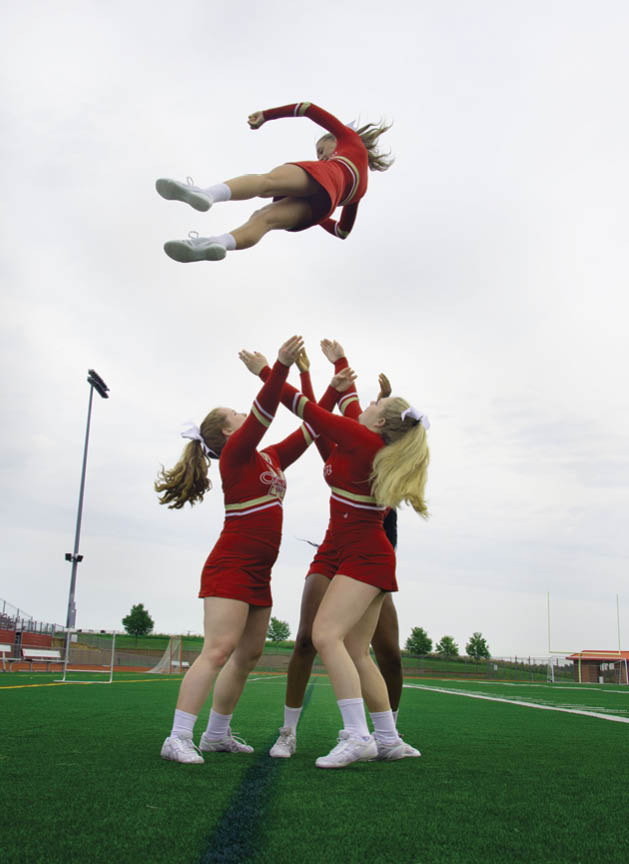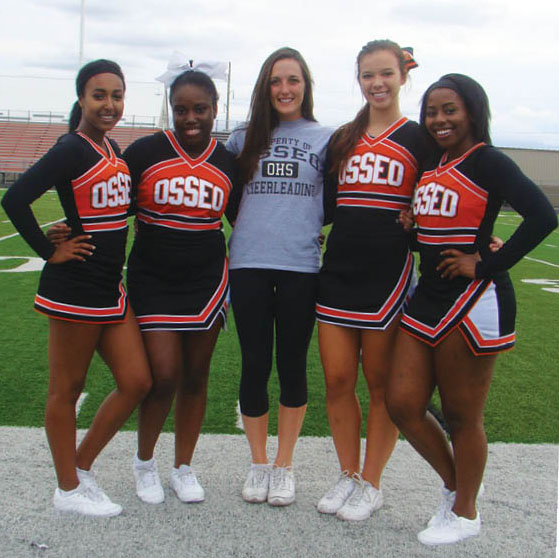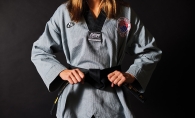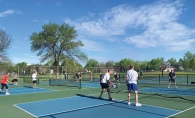It’s Friday night. A brisk fall breeze is blowing through the crowd under bright field lights, and a group of spirited cheerleaders is leading the crowd in chants to motivate the football team to victory. After a long game, the cheerleaders pack up and head home to get some sleep before the next day’s competition.
A typical weekend for cheerleaders in competition season is jam-packed with countless cheers, elite-level stunts, tumbling that amazes the crowd, and jumps that defy gravity. They work tirelessly year-round to perfect their competition routine while also learning new stunts to introduce to fans at games. We caught up with two of the area’s cheerleading teams to learn how they do it, and what it takes to go to the next level.
What It Takes
“The difference between a good cheerleader and a great cheerleader is their attitude, their willingness and commitment to the team, and their talent level with their jumps and abilities,” says Amber Hemingway, cheer coach at Osseo Senior High School.
Fifty cheerleaders make up Osseo’s competition and sideline squads, with two football squads—one in front of the parent section and one in front of the student section at games—and a squad for boys’ and girls’ varsity soccer teams.
“They need to have really good energy and be able to be coached,” Hemingway says. “Some girls are brand-new and don’t know anything. If we can teach them, and they catch on quickly, that’s really important.”
Maple Grove Senior High School’s cheerleading team looks for similar traits in their cheerleaders when forming groups. Made up of 26 girls total, Maple Grove has sideline teams for football and basketball games, as well as a competition team.
“One of the biggest things a cheerleader needs is a good attitude, and be willing to take criticism,” says Alex Papademetriou, cheer coach at Maple Grove Senior High, who also mentions the importance of a great work ethic, responsibility and respect. “Cheerleading is such a team sport—everyone relies on each other and it really boils down to supporting each other no matter what.”
Cheerleading has greatly evolved from simply leading fans in chants to strenuous exercise that pushes the limits of these athletes. Elite stunts and tumbling, two key components of excelling in competition, put participants at risk of injury, which highlights the importance of stunt groups working together to perfect stunts and keeping each cheerleader safe.
Kettie Tesfa, cheer captain at Osseo Senior High, says it’s great to land a stunt every time, “but once you get it perfectly, it’s the best feeling.”


Defying Gravity
The checklist for making the team is much longer than it used to be. Years ago, a big smile and an even bigger voice helped get you a spot on the squad. But now, the bar has been set much higher: Most teams require or prefer that cheerleaders have some tumbling skills—at the very least, somersaults or a back handspring, which involves flipping backwards and using ones hands to push off the ground, returning both feet to terra firma a few feet away. Tumbling is what sets teams apart both in competitions and on the sidelines, amazing the crowd with their abilities.
“Back handsprings are a requirement, but we do have 75 percent of our team that can throw a back handspring or higher,” Papademetriou says. “For the rest of the team, we help them get that skill—we have tumbling clinics and we really emphasize those skills.”
After cheerleaders develop the ability to throw a back handspring, they learn more elite skills such as standing tucks, where cheerleaders launch themselves backwards, tuck their body into a ball in the air, and land on their feet. They also combine skills with a running approach into a round-off back handspring, round-off back tuck or round-off full, where a cheerleader swivels in the air while keeping her body straight.
“My goal is to have a round-off full, but right now I have my round-off back handspring tuck,” says Edwina Dorbor, cheerleader at Maple Grove Senior High. “We want everyone to have a standing handspring, and some people have standing tucks.”
And tumbling isn’t the only challenging aspect of cheerleading: Stunts like basket tosses send cheerleaders flying up into the air, while a “liberty” requires a cheerleader to balance on one foot, held aloft by her stunt group.
“We go through progressions very slowly before moving on to the next level in our stunts,” Hemingway says. Each team is made up of two strong-built cheerleaders called bases; flyers, typically lighter and more flexible athletes who have good balance. The tallest on the team, who are called back spots, control the group.
Stunt groups typically stick together during competitions as well as on the sidelines so they can get used to each other’s way of executing a stunt. Together, they progress in their stunts by utilizing each practice to push their limits.
“Internally, we set a goal that we don’t strive to win every competition, but instead, improve each time and be our personal best,” Papademetriou says. “At each practice, we make sure our stunts are getting more solid because that will get us more points and will help us perform better.”
The basics of stunting start with “preps,” where the flyer stands in the air, held up by her group. From there, the flyer will come down in a “cradle,” where her bases bend down and toss her back up into the air, catching her in a cradle on her descent. Once stunt groups have nailed these skills, they move on to “extensions,” where the flyer is held in the air, with the bases’ arms stretched up as high as they can go. From here, flyers can shift their weight onto one foot, bend the opposite leg to make a “liberty,” or lift their leg up, holding their foot near their face in a “stretch.”
“There are basic rules for stunting depending on what type of cheer team you’re on,” Dorbor says. “For high school cheer, you can do tosses, liberties or extensions, but for college and All-Star cheer, you can pretty much do everything.”
Fans in the Stands
From early May to mid-February, cheer teams fill their schedules with several practices per week—each lasting two to three hours—as well as spending their weekends cheering at games and participating in competitions. Without the enthusiasm and joyful attitudes they bring to every game, fans and athletes alike would surely have a different experience.
“Cheerleaders work every practice and game to have a positive attitude,” Papademetriou says. “When the team is losing, the cheerleaders are there to keep the spirit alive. Without fans in the stands, you don’t have encouragement for players.”
And with so much time spent together perfecting routines, depending on each other in stunts groups, and traveling to and from away games and competitions, cheerleaders grow from being teammates to being close friends.
“It’s a really fun sport, and your team can become your second family—I hang out with my teammates every day,” Dorbor says. “And there’s a lot of teaching from cheerleading; it’s not just cheer, coaches help advise you in life, too.”
And for those that doubt that cheerleading is a sport…
“I encourage you to come to a competition or a practice,” Papademetriou says. “Their endurance and their stamina—it’s tested at every single practice. It all comes down to that work ethic and good attitude.” And, working together as a team is something these athletes will profit from, having learned early and something that pays dividends for the rest of their lives.











